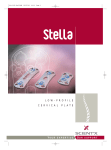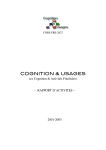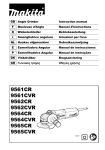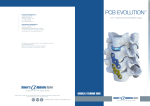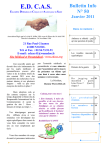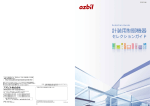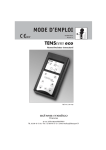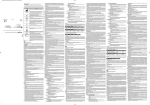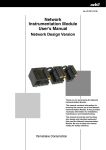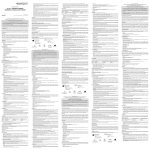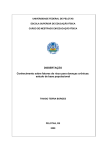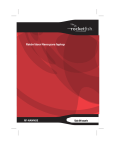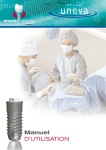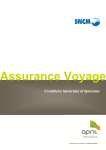Download P E E K A N A T O M I C A L C E R V I C A L C A G E
Transcript
Samarys P E E K ™ A N A T O M I C A L C E R V I C A L C A G E Samarys F E A T U R E S A N D B E N E F I T S The gu of an immediate Features and Benefits of PEEK-OPTIMA® PEEK-OPTIMA® by Invibio™ is a pure PEEK material designed to meet spine, hip and dental implants requirements. Young’s Modulus (GPa) 200 Stainless Steel 150 ® Safety • Elasticity prevents sinking: less risk of endplate penetration • Rupture modulus is lower than metal: less risk of bone damage • Withstands repeated autoclave sterilizations Medical imaging (X-ray, CT, MRI) • Radiolucent material to allow accurate fusion follow-up • Embedded gold markers to facilitate implant placement verification Biocompatibility • No carbon fibres: no risk of inflammatory reaction • CE-marked and cleared by FDA for long-term implantation in the human body 2 PEEK-OPTIMA 100 50 Cancellous bone Cortical bone Titanium TA6V 0 Enhanced bone fusion • No stress shielding • Optimum load repartition • Bone growth enhancement thanks to micromovements Interbody arthodesis is a secure and efficient technique to treat cervical spine pathologies. arantee stability The Samarys™ anterior cage answers all the requirements of this technique. Its unique design allows a maximum interbody fusion. The Samarys™ cage anatomical design offers an optimum stability and its wide range of sizes allows a perfect adaptation to each patient's anatomy. The particular shape and the pure PEEK composition of this implant ensure an excellent bone fusion. Increased stability and fusion Original design for an optimum primary stability to restore the interbody space and preserve cervical lordosis Large graft surface to enhance bone fusion Anatomical shape Designed to maximise contact with the intervertebral endplates Reinforced security Inferior and superior teeth on surface to avoid risks of migration 3 1 Surgical protocol / Patient positioning The procedure is performed under general anesthesia with endotracheal intubation. The patient is positioned in supine position on a standard table. The head is placed in a neutral position or rotated in the opposite direction to the approach. Rotation should be approximately 30° to limit stress on the sterno-cleido-mastoid muscle. The shoulders are lowered and fixed with self-adhesive strips in order to release the inferior cervical spine. The skin incision targets the level of the lesion to be treated. It is marked on the skin after locating the lesion with an image intensifier. It may be horizontal, along a skin fold, extended to the opposite side of the median line in the case of bilateral approach, or beyond according to the number of levels to be treated. The platysma muscle is sectioned on the same plane as the skin, then two upper and lower detachments are created to avoid muscle tension. The aponeurotic planes are sectioned with the finger up to the anterior surface of the spine. The muscles along the neck are separated and rugined to thoroughly release the operating area and allow proper retraction using an autostatic distractor. Under scopic control the proper level is located, then the Caspar distractor pins are positioned in the middle of the vertebral bodies over- and under-lying the discal space to be treated and parallel to the endplates.Then the anterior vertebral ligament is incised, down to the lateral unco-vertebral articular processes, before distracting the space. Discectomy is then carefully performed, if necessary with the help of a microscope. 4 2 Discectomy and preparation of the surgical site The discectomy starts with the rectangular excision of the anterior part of the annulus fibrosus, using a scalpel. The disc material is resected using curettes and rongeurs. It may prove necessary to use a microscope for resecting the posterior disc material. After full discectomy, resecting the posterior osteophytes and the caudal part of the uncus allows foramen release. For simple disc herniations, it may prove sufficient to open the ligament toward the root and remove the herniation. This essential surgical stage gives direct access to the anterior side of the medulla and nerve roots. Cervical distractor 21DST02 Distraction pin Ø 3.5 21FCD35-xx Screwdriver for distraction pin 21TRV03 3 Preparing the vertebral plates The endplate preparation is performed with a curette. This step must be sufficiently thorough in order to extract all discal debris but not so pronounced as to collapse the cancellous bone, which would lead to secondary graft collapse. The intersomatic height may be restored in different ways : autologous, heterologous graft or interbody cages. Plate positioning is performed after resecting the anterior osteophytes. This step is necessary to obtain a close contact between the plate and the anterior vertebral body surface. The choice of the plate and its correct positioning are essential steps of the osteosynthesis. 5 4 Placing the trials implant Trial implant 21CC2Axx-xx A set of implant trials is used to determine the ideal implant size. The width of the trials is 17 or 20 mm and their height is from 5 to 7 mm. These different sizes allow to find the implant that will fit to the anatomies and the needs of the patient. The trial is secured to the holder and is impacted into the intervertebral space. Having no retaining edges, the trial can easily be removed. 5 Graft harvesting and cage filling e e Bone collection device 20TRE01 The cage can be filled with a bone substitute or an autologous graft. In cases of autogeneous bone grafting, the graft harvesting is performed by way of a 15 mm incision on the anterior iliac crest. A specific trefine can be adapted by impact on the iliac crest and allows to obtain a transcortical harvesting on different angles. Generally, one or two samples are enough to fill the cage. The closing of the iliac bone flap is made after haemostesis with wax. Socket for Samarys cage 21SOC02 Graft pusher 21COM03 6 The cage is positioned on its socket during the filling phase. The upper and lower faces of the cage are widely opened to offer optimum graft volume and contact area. A graft pusher matching the cage shape is used to compact the graft. 6 Installing the cage After filling, the cage is secured to the holder tool. The holder is then positioned onto the cage. The end piece of the holder is inserted on the front side of the implant and ensures full locking. The holder has small dimensions and locks in continuation of the cage. The cage can be impacted or installed with slight distraction on the distractor. The stop secured at the top end of the holder allows impacting the implant. The holder is removed after implanting the cage. Cage holder 21CC2Axx Note: The cervical cage ensures immediate post-operative stability of the spine but, in some cases, according to the physician's advice, internal fixation with an anterior cervical osteosynthesis plate, or external collar or brace, can be added according to the surgeon's habits. 7 Closing the approach wound The approach wound is closed after rinsing. The haemostasis is checked and a suction drain is placed on the anterior face of the spine. The platysma muscle must be carefully restored, and the skin closed by intradermic stitches with resorbable thread. 8 Removing the implant If the instrumentation must be removed, before fusion, the cervical approach is used, down to the instrumented area. Bone bridges between the implant and the vertebral bodies must be sectioned. The holder is placed on the cage to facilitate implant removal. 7 Samarys I N S T R U C T Instructions for use The Samarys anterior cervical cage is an implant intended for the surgical treatment of the cervical vertebrae. GENERAL DESCRIPTION: The Samarys anterior cervical cage has been designed for stabilisation and arthrodesis between the cervical vertebrae. The Samarys anterior cervical cage is convex in shape on its upper face and on the openings on the upper and anterior faces. It comes in several sizes to adapt to the variable morphology of the intervertebral spaces. The Samarys anterior cervical cage is made from PEEK. The Samarys anterior cervical cage must not be used with components coming from other manufacturers. INDICATIONS: The Samarys anterior cervical cage is a surgical implant for cervical arthrodesis by anterior route, designed to optimize bone fusion. It is an intersomatic cage whose main function is radicular decompression by intersomatic distraction and a design favouring osteogenesis. The indications include: • stabilisation after treatment of a herniated cervical intervertebral disc or osteophytosis compressing the nerve roots or spinal cord, • degenerative intervertebral instability. CONTRAINDICATIONS : The contra-indications for the Samarys anterior cervical cage include: • local infection or inflammation, • vertebral osteoporosis, • malignant vertebral disease, • allergy or intolerance to PEEK, • incompatible patient age and physical condition, • all cases not included in the indications. The Samarys anterior cervical cage has not been designed, intended or sold for uses other than those indicated. POSSIBLE ADVERSE EFFECTS: • infection, • post-operative migration of the implant , • damage to the vertebrae adjacent to the arthrodesis, • intolerance to the material. > Note: An additional surgical operation may be needed to correct any adverse event. > Warnings: An entirely satisfactory result is not always obtained at each and every operation. This is particularly true in spinal cord surgery where many external factors can compromise the results. OPERATING PRECAUTIONS: The surgeon must be thoroughly familiar with the Samarys anterior cervical cage, the method of application, the instruments and the operating technique (similar to that of the CBK cage). The size of the Samarys anterior cervical cage must be chosen in relation to the individual clinical case and the desired correction. It is recommended to use a Caspar type distractor to open the intervertebral space intended for implanting the cage. Before implanting the Samarys anterior cervical cage, a careful curetage of vertebral faces must be conducted to expose healthy tissue but without making them fragile to prevent the cage from slipping inwards. The Samarys anterior cervical cage must be filled with autologous or allogenic bone or with a bone substitute to obtain bone fusion. The correct positioning of the cage with respect to the vertebrae is confirmed by radiology. After implantation, the batch number and the reference of the implanted Samarys anterior cervical cage must always be recorded in the patient's surgical records. This can be done using one of the labels attached to the sterile packaging. The implants are single-use. A removed implant must never be implanted again. > Warnings: No silicone, formaldehyde or latex based products should be implanted with a SCIENT’X implant. PACKAGING: Implants delivered sterilized are conditioned in individual sterile packages. Implants delivered non-sterile and their instruments are delivered in one or more containers, one (or more) “kits”, except in the case of nonassorted kits for stocks. Each kit must be closed and sealed. The packaging must be intact upon reception. If the stocked kit system is used, complete kit composition must carefully be checked. The proper state of all implants and instruments must be checked prior to any use. Storage conditions must enable implant, accessories and packaging integrity to be maintained. Damaged products must never be used and must be returned to SCIENT'X. products must not be used but must be returned to SCIENT'X. DECONTAMINATION/CLEANING/STERILISATION: Products delivered sachets are not sterile. > For the implants delivered sterile The implants are sterilized by Gamma radiation at doses of 25 to 40 kGy. The expiry date is 5 years. The expiry date of sterile parts is indicated on the packaging. > For implants and instruments not sterile on delivery: All implants and instruments delivered non-sterile must be decontaminated, cleaned and sterilised before and after use. Implants and instruments in sachets must be removed from the original packaging for the following operations: 8 I O N S Recommended method: • Decontamination: Plunge the implants and instruments into a bactericidal and fungicidal solution of the didecyldimethylammonium chloride type diluted to 0.5 % (5mL to 1 litre water). Length of soaking: 20 min. Rinse with demineralized water. • Cleaning: Wash the implants and instruments in a LANCER type machine with suitable cleaning products, rinse and dry. Any product that might damage the equipment is forbidden (such as bleach, formol, etc.). It is essential to sterilise the kit by steam using the following conditions: • Sterilization: It is essential to sterilise the kit by steam using the following conditions: - pre-heating 25 min at 110 °C (1 bar) - vacuum 5 min (0.8 bar under atmospheric pressure ) - heating 5 min at 120 °C (1 bar) - vacuum 5 min (0.8 bar) - sterilization 18 min at 134 °C (2 bar) - drying 20 min return to room temperature COMPLAINTS: Any complaints, together with the reference and lot number of the incriminated product, should be sent to Scient’x. Date of revision of this package insert: 2006/07/24 Notice d’instructions La cage cervicale antérieure Samarys est un implant destiné aux traitements chirurgicaux du rachis cervical. DESCRIPTION GENERALE : La cage cervicale antérieure Samarys a été conçue pour permettre la stabilisation et l'arthrodèse inter-somatique cervical. La cage cervicale antérieure Samarys présente une forme convexe sur sa face supérieure et des ouvertures sur les faces supérieures et antérieures. Plusieurs hauteurs et largeurs sont proposées pour s'adapter aux différentes morphologies d'espaces inter-vertebraux. La cage cervicale antérieure Samarys est fabriquée à partir de PEEK. La cage cervicale antérieure Samarys ne doit pas être utilisée avec des composants provenant d'autres fabricants. INDICATIONS : La cage cervicale antérieure Samarys est un implant chirurgical pour l'arthrodèse cervicale par voie antérieure, conçue pour optimiser la fusion osseuse. C'est une cage intersomatique dont les principaux objectifs sont de permettre une décompression radiculaire par distraction intersomatique et une conception favorisant l'ostéogenèse. Les indications comprennent : • stabilisation après cure de hernie discale cervicale ou d'ostéophytose, compressive sur les racines nerveuses et/ou sur la moelle. • instabilité intervertébrale dégénérative. CONTRE-INDICATIONS : Les contre-indications de la cage cervicale antérieure Samarys comprennent: • infection ou inflammation locale, • ostéoporose vertébrale, • affection vertébrale maligne, • allergie ou intolérance au PEEK, • âge et état physique du patient incompatibles, • tout cas non compris dans les indications. La cage cervicale antérieure Samarys n'est pas conçue, destinée ou vendue pour des utilisations autres que celles indiquées. EFFETS SECONDAIRES POSSIBLES : • infection, • migration post-opératoire de l'implant , • atteintes des étages vertébraux adjacents à l'arthrodèse, • intolérance au matériel. > Note : Une intervention chirurgicale supplémentaire peut être nécessaire pour corriger un effet secondaire. > Avertissements : Un résultat entièrement satisfaisant n'est pas systématiquement obtenu à chaque opération chirurgicale. Cela est particulièrement vrai en chirurgie du rachis où de nombreux éléments extérieurs peuvent compromettre les résultats. PRECAUTIONS OPÉRATOIRES : Le chirurgien doit être parfaitement familiarisé avec la cage cervicale antérieure Samarys, la méthode d'application, les instruments et la technique opératoire (similaire à celle de la cage CBK). La taille de la cage cervicale antérieure Samarys doit être choisie en fonction du cas clinique et de la correction désirée. Il est recommandé d'utiliser un distracteur de type Caspar pour ouvrir l'espace intervertébral destiné à recevoir la cage. Avant implantation de la cage cervicale antérieure Samarys, les plateaux vertébraux doivent être curetés soigneusement et avivés sans être fragilisés pour éviter les risques d'enfoncement de la cage. La cage cervicale antérieure Samarys doit être remplie d'os autologue, allogénique ou d'un substitut osseux pour obtenir la fusion osseuse. Un contrôle radiographique permet de constater le bon positionnement de la cage par rapport aux vertèbres. Après implantation, le numéro de lot et la référence de la cage cervicale antérieure Samarys implantée doivent systématiquement être enregistrés dans le dossier chirurgical du patient. Les implants sont à usage unique. Un implant désimplanté ne doit jamais être réimplanté. EMBALLAGE : Les implants livrés stériles sont conditionnées dans des emballages stériles individuels. Les implants livrés non stériles et leurs instruments sont livrés dans un ou plusieurs conteneur, un(des) « kit », sauf dans le cas de réassortiment de kit(s) en dépôt. Chaque kit doit être fermé et scellé ; l'emballage doit être intact à réception. Si le système de kit en dépôt est utilisé, la composition complète du kit doit être attentivement vérifiée. Le bon état de tous les implants et instruments doit être contrôlé avant toute utilisation. Les conditions de stockage doivent permettre de maintenir l'intégrité des implants, des ancillaires associés et de leurs emballages respectifs. Les produits endommagés ne doivent pas être utilisés et doivent être retournés à SCIENT'X. > Attention : Aucun produit à base de silicone, de formaldéhyde ou de latex ne doit être implanté avec un implant SCIENT’X . DÉCONTAMINATION/NETTOYAGE/STERILISATION : Les produits livrés en sachets ne sont pas stériles. > Pour les implants livrés stériles : Les implants sont stérilisés par rayonnement Gamma à la dose de 25 à 40 kGy. Le délai de péremption est de 5 ans. La date limite d’utilisation des éléments stériles est indiquée sur l’emballage. > Pour les implants et instruments livrés non stériles : Tous les implants et instruments livrés non stériles doivent êtres décontaminés, nettoyés et stérilisés avant et après utilisation. Les implants et les instruments en sachet doivent être sortis de leur emballage d'origine pour les opérations suivantes : Méthode conseillée : • Décontamination : Plonger les implants et les instruments dans une solution bactéricide et fongicide de type chlorure didécyldiméthylammonium diluée à 0,5 % (5ml pour 1 litre d'eau tiède). Durée du trempage: 20 min. Rincer à l’eau déminéralisée. • Nettoyage : Laver les implants et les instruments en machine de type LANCER avec des produits de nettoyage adaptés, rincer, sécher. Tout produit susceptible d'altérer le matériel est à proscrire (eau de javel, formol…). Il est impératif de stériliser le kit par le procédé à vapeur d'eau en utilisant les paramètres suivants: • Stérilisation : Nous recommandons le mode de stérilisation en autoclave pour les implants et les instruments : - préchauffage 25' à 110 °C (1 bar) - vide 5' (0,8 bar sous pression atmosphérique) - chauffage 5' à 120 °C (1 bar) - vide 5' (0,8 bar) - stérilisation 18' à 134 °C (2 bars) - séchage 20' retour à l'ambiante RECLAMATIONS : Toute réclamation, accompagnée de la référence et du numéro de lot du produit incriminé, doit être transmise à la société Scient’x. Date de révision de cette notice : 24/07/2006 Gebrauchsanweisung Der anteriorer Zervikal-Cage Samarys ist ein Implantat zur chirurgischen Behandlung der Halswirbelsäule. ALLGEMEINE BESCHREIBUNG : Der anteriore Zervikal-Cage Samarys ist speziell zur Stabilisierung und Spondylodese der Halswirbel konzipiert. Der anteriore Zervikal-Cage Samarys hat eine konvexe Oberseite und große Öffnungen oben und seitlich. Es gibt ihn in mehreren, zu den verschiedenen Ausgestaltungen des Zwischenwirbelraums passenden Höhen und Breiten. Der anteriore Zervikal-Cage Samarys ist aus Polymer (PEEK). Der anteriore Zervikal-Cage Samarys darf nicht zusammen mit Komponenten von anderen Herstellern verwendet werden. ANWENDUNGSGEBIETE : Der anteriore Zervikal-Cage Samarys ist ein chirurgisches Implantat zur Spondylodese im Bereich der HWS durch anteriore Fixierung, und seine Konzeption optimiert die Knochenfusion. Die vornehmliche Zweckbestimmung dieses interkorporellen Käfigs ist die Wurzeldekompression durch intervertebrale Aufdehnung, und seine Konzeption begünstigt die Osteogenese. Zu den Indikationen zählen: • Stabiliserung nach operativer Behandlung eines zervikalen Bandscheibenprolapsus oder einer Osteophytose mit Nervenwurzelund/oder Rückenmarkskompression • degenerative intervertebrale Instabiltität KONTRAINDIKATIONEN : Zu den Kontraindikationen des anteriore Zervikal-Cages Samarys zählen: • Infektion oder örtliche Entzündung • vertebrale Osteoporose • bösartige Wirbelerkrankung • Allergie gegen oder Unverträglichkeit mit Polyetheretherketon (PEEK) • Patient in einem nicht operationsfähigen Alter oder Gesundheitszustand • alle nicht unter die Anwendungsgebiete fallenden Befunde Der anteriore Zervikal-Cage Samarys ist ausschließlich für die erwähnten Verwendungszwecke konzipiert. Er eignet sich für keinen anderen Verwendungszweck und wird auch nicht dazu zum Verkauf angeboten. Manual de instrucciones MÖGLICHE NEBENWIRKUNGEN : • Infektion • postoperative Migration des Implantats • Verletzung der an die Spondylodese angrenzenden Wirbeletagen • Unverträglichkeitsreaktion auf das Material > Hinweis : Zur Korrektur einer Nebenwirkung kann eine zusätzliche Operation erforderlich werden. > Warnung : Nicht jeder operative Eingriff ergibt immer ein zufriedenstellendes Ergebnis. Das gilt vor allem auch bei Wirbelsäulenoperationen, wo das Ergebnis durch viele äußere Faktoren beeinträchtigt werden kann. La caja cervical anterior Samarys es un implante para tratamiento quirúrgico de la columna cervical. VORSICHTSMASSNAHMEN BEI DER OPERATION : Der Chirurg muss mit dem anterioren Zervikal-Cage Samarys, der Applikationsmethode, dem Instrumentarium und der Operationstechnik vertraut sein (sie ist ähnlich wie beim Cage CBK). Bei der Auswahl der Größe des anterioren Zervikal-Cages Samarys lasse man sich von dem klinischen Fall und der gewünschten Korrektur leiten. Zum Öffnen des Zwischenwirbelraums, in den der Käfig implantiert werden soll, empfiehlt sich die Verwendung eines Distraktors vom Caspar-Typ. Vor der Implantation des anterioren Zervikal-Cages Samarys werden die Abschlussplatten der Wirbelkörper sorgfältig kürettiert und angefrischt, ohne sie jedoch brüchig zu machen, damit der Käfig nicht einsinkt. Der anteriore Zervikal-Cage Samarys muss mit autologem, allogenem Knochen oder einem Knochenersatz angefüllt werden, um die Knochenfusion zu ermöglichen. Die richtige Positionierung des Käfigs im Verhältnis zu den Wirbeln wird mit Röntgen kontrolliert. Nach der Implantation müssen immer die Los- und Bestellnummern der implantierten anterioren Zervikal-Cages Samarys in die Operationsunterlagen des Patienten eingetragen werden. Die Implantate sind nur zum einmaligen Gebrauch. Explantierte Implantate dürfen auf keinen Fall wiederverwendet werden. > Achtung : Bei SCIENT’X Implantaten dürfen keine silikon- oder formaldehyd- oder latexhaltigen Produkte implantiert werden. VERPACKUNG : Die steril gelieferten Implantate sind einzeln steril verpackt. Die nicht-steril gelieferten Implantate und ihre Instrumente werden in einem oder mehreren Behältern, so genannten "Sets" geliefert, außer bei der Auffüllung von vor Ort gelagerten Sets. Jedes Set muss verschlossen und versiegelt sein; die Verpackung muss bei Erhalt intakt sein. Wird des gelagerte Setsystem verwendet, muss die vollständige Zusammensetzung des Sets sorgfältig überprüft werden. Der einwandfreie Zustand sämtlicher Implantate und Instrumente muss vor jeder Anwendung kontrolliert werden. Die Lagerbedingungen müssen zur Erhaltung der Integrität der Implantate, des Zubehörs und ihrer jeweiligen Verpackungen geeignet sein. Verwenden Sie beschädigte Produkte nicht und senden Sie sie an SCIENT'X zurück. DEKONTAMINATION, REINIGUNG UND STERILISATION : Die in Beuteln gelieferten Produkte sind nicht steril. > Bei steril gelieferten Implantaten : Die Implantate werden mit Gammastrahlen bei einer Dosis von 25 bis 40 kGy sterilisiert. Die Verfallszeit beträgt fünf Jahre. Das Verfallsdatum der sterilen Teile steht auf der Verpackung. > Bei nicht steril gelieferten Implantaten und Instrumenten : Alle nicht steril gelieferten Implantate und Instrumente müssen vor und nach Gebrauch dekontaminiert, gereinigt und sterilisiert werden. Die Implantate und Instrumente in Beuteln müssen aus ihrer Originalverpackung genommen und folgenden Behandlungen unterzogen werden: Empfohlene Methode: • Dekontamination : Die Implantate und Instrumente in eine bakterizide und fungizide, zu 0,5 % verdünnte Lösung vom Typ Didecyldimethylammonium-Chlorid tauchen (5 ml auf 1 Liter lauwarmes Wasser). Baddauer: 20 Min. Danach mit demineralisiertem Wasser abspülen. • Reinigen : Die Implantate und Instrumente in einer Maschine Typ LANCER mit geeigneten Reinigungsmitteln waschen, abspülen und trocknen. Es dürfen keine Mittel verwendet werden, die das Material angreifen könnten (Chlor, Formalin usw.). • Sterilisation : Wir empfehlen die Autoklav-Sterilisation für Instrumente : - Vorheizen 25’ bei 110° (1 Bar) - 5' Vakuum (0,8 Bar unter atmosphärischem Druck) - Heizen 5' bei 120° (1 Bar) - 5' Vakuum (0,8 bar) - Sterilisation 18' bei 134 °C (2 bar) - Trocknen 20’ Rückgang auf Raumtemperatur REKLAMATIONEN : Alle Reklamationen müssen zusammen mit der Referenz und der Chargennummer des beanstandeten Produktes an die Firma Scient’x geschickt werden. Letzte Überarbeitung dieser Gebrauchsanweisung : 24/07/2006 DESCRIPCIÓN GENERAL : La caja cervical anterior Samarys ha sido concebida para la estabilización y la artrodesis intersomática cervical. La caja cervical anterior Samarys tiene forma convexa en la cara superior y aberturas en las caras superiores y anteriores. Se fabrica en varias alturas y anchuras para adaptarla a las diversas morfologías de los espacios intervertebrales. La caja cervical anterior Samarys se fabrica en material PEEK. La caja cervical anterior Samarys no debe utilizarse con elementos procedentes de otros fabricantes. INDICACIONES : La caja cervical anterior Samarys es un implante quirúrgico para artrodesis cervical por vía anterior, concebido para lograr una fusión ósea óptima. Es una caja intersomática cuyos principales objetivos son lograr la descompresión radicular por separación intersomática y favorecer la osteogénesis gracias a su diseño. Las indicaciones son: • estabilización tras cura de hernia discal cervical o de osteofitosis, compresiva sobre las raíces nerviosas y/o sobre la médula. • inestabilidad intervertebral degenerativa. CONTRAINDICACIONES : Las contraindicaciones de la caja cervical anterior Samarys son : • infección o inflamación local, • osteoporosis vertebral, • afección vertebral maligna, • alergia o intolerancia a la polieterotercetona (PEEK), • edad y estado físico del paciente incompatibles, • cualquier caso no incluido en las indicaciones. La caja cervical anterior Samarys no está pensada ni se vende para otros usos que los indicados. > Para los implantes e instrumentos que se entregan sin esterilizar : Todos los implantes e instrumentos que se entregan sin esterilizar deben ser descontaminados, limpiados y esterilizados antes y después de su uso. La descontaminación disminuye la población de microorganismos y facilita la limpieza ; además, la esterilización solamente será eficaz si el material está limpio. Método aconsejado: • Descontaminación : Sumergir los implantes y los instrumentos en una solución bactericida y fungicida de tipo cloruro didecilmetilamonio diluida al 0,5 % (5 ml por 1 litro de agua tibia). Duración del remojo : 20 min. Enjuagar con agua desmineralizada. • Limpieza : Lavar los implantes y los instrumentos en una máquina tipo LANCER con productos de limpieza adaptados, enjuagar y secar. Debe evitarse todo producto susceptible de alterar el material (lejía, formol...). Es obligado esterilizar el kit por el procedimiento de vapor de agua ajustándose a los siguientes parámetros : • Esterilización : Recomendamos la esterilización en autoclave para los implantes y los instrumentos : - precalentamiento 25' a 110 °C (1 bar) - vacío 5' (0,8 bares bajo presión atmosférica) - calefacción 5' a 120 °C (1 bar) - vacío 5' (0,8 bares) - esterilización 18' a 134 °C (2 bares) - secado 20' retorno a temperatura ambiente RECLAMACIONES: Cualquier reclamación, acompañada de la referencia y del número de lote del producto correspondiente, debe dirigirse a la sociedad Scient’x. Fecha de la actualización del folleto : 24/07/2006 EFECTOS SECUNDARIOS POSIBLES : • infección, • desplazamiento postoperatorio del implante, • afectación de los estratos vertebrales adyacentes a la artrodesis, • intolerancia al material. > Nota : Puede ser necesaria una intervención quirúrgica complementaria para corregir un efecto secundario. > Advertencia : No siempre se obtienen resultados completamente satisfactorios en todas las intervenciones quirúrgicas. Ello es especialmente aplicable a la cirugía de la columna vertebral, en que son numerosos los elementos externos que pueden comprometer los resultados. PRECAUCIONES OPERATORIA : El cirujano debe estar perfectamente familiarizado con la caja cervical anterior Samarys, el método de implantación, los instrumentos y la técnica operatoria (similar a la de la caja CBK). El tamaño de la caja cervical anterior Samarys se debe escoger en función del caso clínico y de la corrección que se desee hacer. Se recomienda utilizar un distractor (separador) tipo Caspar para abrir el espacio intervertebral destinado a recibir la caja. Antes del implante de la caja cervical anterior Samarys, debe hacerse un cuidadoso curetaje de los platillos vertebrales para avivarlos pero sin tornarlos frágiles en evitación del riesgo de hundimiento de la caja. La caja cervical anterior Samarys debe rellenarse con hueso autólogo, alogénico o con un sustitutivo óseo para lograr la fusión ósea. El control radiológico permite confirmar que la caja está en posición correcta respecto a las vértebras. Tras el implante, el número de lote y la referencia de la caja cervical anterior Samarys implantada deben anotarse sistemáticamente en el informe quirúrgico del paciente. Los implantes son para un solo uso. Una vez extraído un implante nunca debe volver a implantarse. > Atención : No debe implantarse ningún producto a base de silicona, formal debido o látex con un implante SCIENT’X. EMBALAJE : Los implantes suministrados estériles están acondicionados en embalajes estériles individuales. Los implantes suministrados no estériles y sus instrumentos son suministrados en uno o varios contenedor, uno(varios) “kit”, excepto en el caso de renovación de kit(s) en depósito. Cada kit debe estar cerrado y sellado; el embalaje debe estar intacto a la recepción. Si se utiliza el sistema de kit en depósito, la composición completa del kit debe ser atentamente verificada. El buen estado de todos los implantes e instrumentos debe ser controlado antes de cualquier uso. Las condiciones de almacenamiento deben permitir mantener la integridad de los implantes, del material auxiliar asociado y de sus embalajes respectivos. Los productos dañados ser utilizados y deben ser devuetos a SCIENT'X. DESCONTAMINACIÓN, LIMPIEZA Y ESTERILIZACIÓN : Los productos entregados en bolsas no son estériles. > Para los implantes que se entregan estériles : Los implantes están esterilizados por radiación Gamma a dosis de 25 a 40 kGy. El plazo de caducidad es de 5 años. La fecha límite de uso de los elementos estériles viene indicada en el embalaje. Additional information / Renseignements / Weitere Angaben / Informações complementares Bâtiment Calypso - Parc Ariane 3 5, rue Alfred Kastler 78284 Guyancourt FRANCE TL +33 (0)1 39 30 69 30 FX +33 (0)1 30 43 82 77 www.scientx.com - [email protected] 9 Poster presented at the CSRS Meeting, Barcelona, June 2003 Samarys 10 E V A L U A T I O N Samarys I M P L A N T S / I N S T R U M E Implants N T S width PEEK cervical cage - Length 15 mm Height (mm) Width (mm) Reference 05 17 11CC2A17-5 06 11CC2A17-6 07 11CC2A17-7 08 11CC2A17-8* 09 11CC2A17-9* 10 05 length 11CC2A17-10* 20 11CC2A20-5 06 11CC2A20-6 07 11CC2A20-7* 08 11CC2A20-8* 09 11CC2A20-9* 10 11CC2A20-10* Available sterile (11CC2A_ ) height Short PEEK cervical cage - Length 13 mm Height (mm) Width (mm) Reference 5 17 11CC2AC17-5 6 11CC2AC17-6 Instruments Trial implant for: Reference 11CC2A17-5 21CC2A17-5F 11CC2A17-6 21CC2A17-6F 11CC2A17-7 21CC2A17-7F 11CC2A20-5 21CC2A20-5F 11CC2A20-6 21CC2A20-6F 11CC2AC17-5 21CC2AC17-5F 11CC2AC17-6 21CC2AC17-6F Length (mm) Reference Distraction pin Ø 3.5 14 21FCD35-14 16 21FCD35-16 18 21FCD35-18* Bone collection device guide 20TRE01 (1/3) + Bone collection device 20TRE01 (2/3) + Graft pusher for bone collection device 20TRE01 (3/3) Graft pusher 21COM03 Cervical distractor Cage holder 21DST02 200 21ICC2A01 Cage holder with stopper 21ICC2A03 Socket for Samarys cage 21SOCO2 Screwdriver for distraction pin 21TRV03 Pliers 030929 * On request 11 Samarys P E E K C E R V I A N A T O M C A L A C I C G E A L Bâtiment Calypso - Parc Ariane 3 5, rue Alfred Kastler 78284 Guyancourt FRANCE Please read carefully the instructions for use bulletin. Devices may be subject to modification. Patented 88BTN11CC2A-A / Version 2.0 July 2006 TL +33 (0)1 39 30 69 30 FX +33 (0)1 30 43 82 77 www.scientx.com - [email protected]












